Devdas, 2002 (Hindi) is a ‘classic epic romantic’ movie directed by Sanjay Leela Bhanshali and produced by Bharat Shah under his banner, ‘Mega Bollywood’. It stars Shah Rukh Khan, Aishwariya Rai Bachchan, and Madhuri Dixit along with Kirron Kher, Smita Jaykar and in supporting roles. Based on the 1917 novel of the same title by Sarat Chandra Chattopadhyay, the movie narrates the story of Devdas Mukherjee (Shah Rukh), a wealthy law graduate who returns from London to marry his childhood friend, Parvati “Paro” (Aishwariya). However, the rejection of their marriage by his own family sparks his descent into alcoholism, ultimately leading to his emotional deterioration and him seeking refuge with the golden-hearted courtesan Chandramukhi (Madhuri).
The movie not only succeeded in capturing millions of hearts but it is still intact in their memory as they swooned, laughed, cried and shared the melancholy with the characters. Apart from this, the movie was the one of the biggest blockbusters of the decade. Devdas was premiered at the 2002 Cannes Film Festival on 23 May 2002 and was released worldwide on 12 July that year. It was the most expensive Indian movie at that time, with a budget of ₹500 million (US$7.0 million). The film got mixed-to-negative reviews when it premiered at Cannes, but was better received when it was theatrically released. The film was a commercial success and emerged as the highest-grossing Indian film of the year, earning ₹998.8 million (US$14 million) in both India and overseas. It won several awards, including five National Film Awards and eleven Filmfare Awards; the latter includes trophies for Best Film, Best Director (Bhansali), Best Actor (Shah Rukh), Best Actress (Aishwariya), and Best Supporting Actress (Madhuri).
The movie’s intricate sets played a huge role in rising its cost, and these stood in place for around 7-9 months. The most expensive set was that of Chandramukhi’s kotha that cost around Rs 12 crore. The set of Paro’s house was created using stained glass and because it rained during filming, the glass had to be painted over and over again. The use of equipment on the set resulted in the glass getting chipped and that had to be touched up over and over again. This set used over 1.2 lakh pieces of stained glass and was cost around Rs 3 crore. Additionally, Devdas used 42 generators on the movie set and that was because of the number of lights that were required for the film. Cinematographer Binod Pradhan used 2500 lights which needed over 700 lightmen, and that resulted in the film’s awe-inspiring visuals.
The movie also had flamboyant outfits, designed by Abu Jani-Sandeep Khosla, Madhuri Dixit’s outfits in the movie were nothing short of exquisite. It was widely reported at the time that every ensemble worn by Dixit cost approximately Rs 15 lakh. A ghaghra worn by the actor in the song ‘Kahe Chhed Cheed Mohe’ weighed around 30 kgs and since she had to dance in it, it proved to be quite a challenge. The outfit was later replaced by a lighter one, which too was around 16 kgs. Another costume worn by Dixit cost around 10 kgs and was completed in two months by artisans. Meanwhile, for Aishwariya’s look designer Neeta Lulla and director Bhansali shopped for around 600 sarees from Kolkata and thus, the look of Paro was born. Different sarees were mixed to create new looks for her character and a new style of draping those sarees was created by Lulla that took approximately three hours every day. While a traditional saree in 6 metres, sarees created for Paro were 8-9 metres to create a grand effect.
The movie gave evergreen super-hit songs, Ismail Darbar created the iconic songs of the film but it took two years for the music of this film to be completed. Every song’s recording lasted around 10 days and then it was mixed 8-9 times. Darbar and Bhansali had many tiffs during this period but they resolved their differences later. One of the lines from ‘Dola Re Dola’ was changed by Nusrat Badr at the final mixing stage and this raised the cost even further. In 2002, Devdas was the top-earner of the year minting Rs 41.66 crore on the domestic market, which was a huge deal in those days. The second film that earned the most this year was Raaz, earning Rs 21.46 crore.


